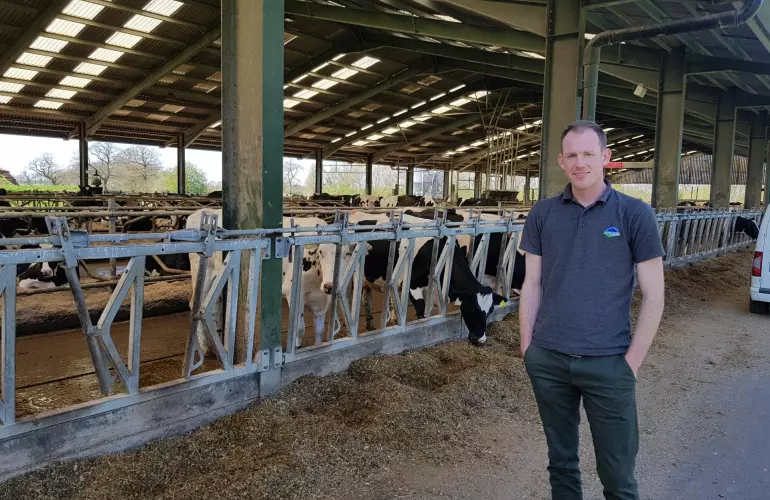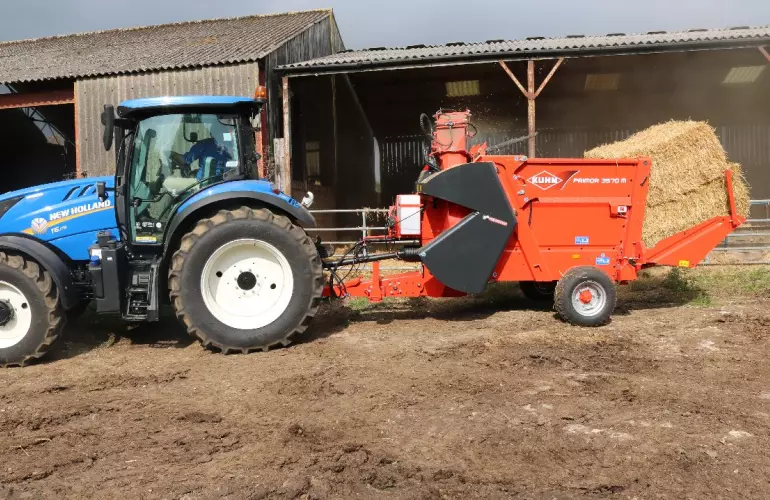When bales were small and stored in dry barns, and bedding was spread with a pitch fork, dust wasn’t such a big issue in cattle sheds.
Now that’s changed, and most straw is in round or big square bales, often stored outside, potentially contaminated, and is increasingly chopped through a spinning turbine and blown into sheds from above.
Modern methods save time and labour, and may use less straw, but the downside is the risk of airborne particles – something that can impact on the health of cattle and anyone working in that environment.
“We see a lot of problems resulting from poor air quality in cattle sheds, and dust can certainly be a factor,” says Dan Humphries of the specialist dairy veterinary consultancy Dairy Insight. “There’s obviously the challenge to respiratory health, but dust can also be a cause of eye problems, with runny eyes attracting flies and leading to conditions such as New Forest Eye. We should also consider how working in a dust-filled environment can affect human health, with conditions such as Farmers’ Lung a possible consequence.”
When it comes to lung health in cattle, it’s hard to under estimate the importance of clean air, and understanding some basic physiology certainly helps to drive the point home.
“Cattle are at a disadvantage from day one when it comes to their lungs, as they have less than half the respiratory capacity of any other mammal of comparable size,” explains Dan. “It’s also important to appreciate that lung damage tends to be permanent, so any impairment created in young calves, for example, is a problem for life.”

Dust is likely to contain pollen, moulds, bacteria and tiny fragments of plant residue. When cattle are exposed to a lot of it, their defense mechanisms can be over powered. The mucus and fine hairs in their trachea and bronchi – which are there to intercept foreign particles – can become ineffective and the animal’s immune system becomes compromised. This increases the likelihood of bacterial infections, and the damaging result can be pneumonia.
Dan adds: “I’ve seen situations where avoiding exposure to dust has been the key factor in preventing pneumonia in calves, so it is a very real risk and something that can have a life-long impact on animal performance.”
Minimising the impact of dust
Dust extraction - as is the norm in bedding and feeds for performance horses for example - is unrealistic on a livestock farm, but a good starting point will be to avoid using straw that is contaminated with moulds or soil.
Another recommendation is to remove cattle from sheds when bedding machines are operating. This is something that could be worked into some farms’ routines, but may not always be practical or possible.
One company with an alternative solution is Kuhn Farm Machinery, who now offer a dust control system within their straw bedding equipment range.

Available on new equipment, or as a retrofit upgrade for existing machines, the Cleanstraw facility reduces dust in livestock buildings by applying a fine mist of water to straw as it is distributed. It comprises a 64 litre water tank and three misting nozzles mounted at the exit of the straw blowing chute. The nozzles are fed by a pump, which provides water at a flow rate sufficient to apply one litre of water per 100kg of straw, without slowing the machine’s normal performance.

Applying a mist of water at this rate and in this way eliminates excessive levels of airborne dust by reducing the amount of time that these particles remain suspended in the air. Trials have shown that the air in a typical livestock building will be dust-free within 30 seconds after straw-blowing with the Cleanstraw system has ceased. This compares to several minutes under normal conditions.
Kuhn product specialist Katie Calcutt explains: “Reducing the amount of dust in livestock buildings has a number of advantages. It not only creates a cleaner, more comfortable and more productive environment for cattle, but is also far better for farm workers who will be less susceptible to inhaling dust particles and other impurities which may be present in the straw.
“Adding a fine mist of water as straw exits the spreading chute means very little water is required. This not only preserves the straw’s absorbency potential, ensuring it remains an effective and hygienic bedding material, but also means the speed of operation is unaffected.”
The Cleanstraw system is available on Kuhn’s Primor straw bedders that operate with the Polydrive hydraulically disengageable belt system that drives the feed rotor, and on the Profile Plus range of mixer wagons that have a bedding capability. The system is automatically activated when the Polydrive is engaged and can also be armed or disabled via an in-cab switch.
